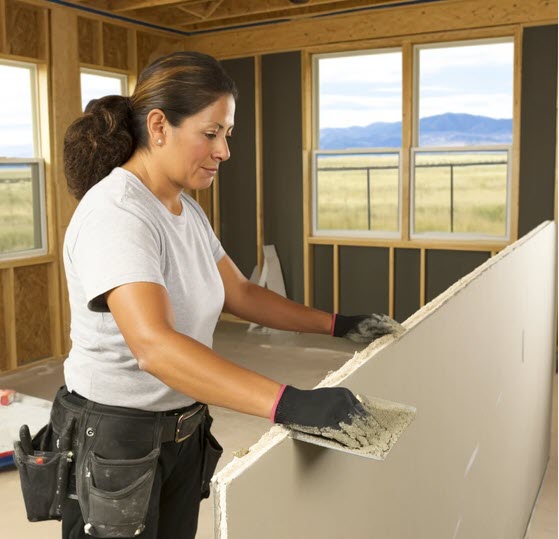Trusted Drywall Fort Worth Specialists for Seamless Outcomes
Trusted Drywall Fort Worth Specialists for Seamless Outcomes
Blog Article
Total Guide to Efficient and Reliable Drywall Installation
Drywall setup is a critical element of any building or renovation job, requiring a precise strategy to guarantee both performance and reliability. It is necessary to explore the subtleties of each action in the procedure, as they collectively add to the total success of the drywall installment.
Vital Devices for Drywalling
When embarking on a drywall setup task, having the right tools is vital for attaining a professional surface. Crucial tools include a drywall knife, measuring tape, and a T-square, which are fundamental for exact measurements and smooth cuts. A drywall lift is also extremely advantageous, especially for ceiling installments, permitting less complicated handling of heavy panels.
For attaching the drywall, a cordless drill and drywall screws are essential. The drill needs to be furnished with a drywall little bit to make certain efficiency and accuracy. Additionally, a vital tool is the drywall saw, which facilitates reducing around electric outlets and various other barriers.

Furthermore, protective equipment such as safety and security glasses and a dirt mask are vital to make certain individual security during the installation procedure. Making use of the right devices not only enhances the quality of the installment yet likewise improves the workflow, making the task more efficient total.
Preparing the Space

Following, assess the problem of the ceilings and wall surfaces. Repair any type of existing damages, such as holes, fractures, or peeling paint, to make sure a smooth and even surface area for drywall application. Additionally, look for electric outlets, plumbing lines, and cooling and heating ducts, noting their locations to prevent complications during installment.
It is also critical to determine the room accurately, figuring out the measurements of the ceilings and wall surfaces to compute the suitable quantity of drywall required. Create an in-depth strategy that includes the layout and positioning of the drywall panels.
Installment Techniques
Effective setup techniques are important for attaining a specialist surface in drywall projects. Proper measurement and cutting of drywall sheets are essential steps.
When hanging drywall, start from the original source the top and work downward, making sure that the lengthy side of the board is vertical to the framing. Protect the sheets with screws as opposed to nails, which supply higher holding power and minimize the danger of popping. Location screws every 12 inches along the edges and every 16 inches in the field of the board.
For corners, use edge grains to attain sharp, tidy edges. When setting up on ceilings, use a drywall lift or have a partner aid in holding the sheets in area (drywall installation). Preserve a gap of concerning 1/4 inch above the floor and ceiling to suit development and tightening
Completing Touches

When the tape is in place, it's time to use the first layer of joint compound, likewise known as mud. Utilize a 10 to 12-inch taping blade to spread the compound equally over the taped seams, feathering the edges to mix with the bordering drywall.
Enable the compound to dry completely, normally 24 hours. After drying out, sand the surface lightly with fine-grit sandpaper to remove any type of blemishes. drywall fort worth. Repeat the mudding and sanding procedure, usually 2 to 3 coats, making certain each layer is smooth and flush with the drywall surface
Usual Mistakes to Prevent
Several Do it yourself fanatics encounter pitfalls during drywall setup that can jeopardize the final results. One typical error is stopping working to appropriately reduce and determine drywall sheets.
An additional constant mistake is incorrect fastening. Utilizing as well few screws or nails can result in loose drywall, while overdriving fasteners can create the paper to tear, damaging the framework. It's critical to keep regular spacing, normally every 16 inches, and to make sure that bolts are flush with the surface.
Furthermore, not addressing moisture concerns prior to setup can result in mold and mildew growth and structural damage. Always analyze the setting and usage moisture-resistant drywall in high-humidity locations.
Conclusion
Effective and dependable drywall setup requires careful focus to information throughout the process. By utilizing crucial tools, preparing the space effectively, investigate this site and adhering to ideal practices in installation strategies, a perfect surface can be achieved. Furthermore, cautious application of joint substance and tape during the finishing stage boosts toughness and appearance. Preventing common mistakes additionally adds to a professional outcome, underscoring the value of precision and method in successful drywall projects.
It is necessary to explore the subtleties of each step in the process, as they collectively contribute to the total success of the drywall installation.When getting started on a drywall setup project, look at this website having the right devices is important for accomplishing a professional coating.For fastening the drywall, a cordless drill and drywall screws are necessary.Correctly preparing the space is necessary for a successful drywall installment.Reliable installation strategies are critical for attaining a specialist finish in drywall jobs.
Report this page